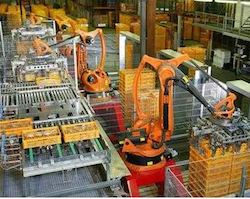Manufacturing Rebound Benefits Not Shared Equally
 A recent report from the U.S. Department of Commerce, Economics and Statistics Administration (ESA), while acknowledging the importance of manufacturing in the economic recovery, clearly indicates that the benefits from a resurgent manufacturing sector are not being spread uniformly across the U.S.
A recent report from the U.S. Department of Commerce, Economics and Statistics Administration (ESA), while acknowledging the importance of manufacturing in the economic recovery, clearly indicates that the benefits from a resurgent manufacturing sector are not being spread uniformly across the U.S.
Manufacturing is one of the “major bright spots” in the recovery, writes author Brittany M. Bond, a research economist with ESA. The sector has been responsible for contributing more than 25 percent of the overall growth in GDP (gross domestic product) between 2009 and 2011. In 2011, manufacturing accounted for 11.9 percent of the GDP, up from 11.3 percent in 2009.
The report also states that manufacturing was responsible for 68 percent of domestic investment in U.S. research and development and 60 percent of its total exports. Importantly, the revitalized manufacturing sector has generated about 500,000 new jobs from the beginning of 2012 to the end of 2012.
In keeping with the way manufacturing continues to evolve in this country, many of these jobs call for higher skill levels. As a result, they provide higher wages and better benefits than non-manufacturing jobs.
Of course, some parts of the country are benefitting more from the uptick than others. We all know that manufacturing industries are concentrated in certain locations, such as the Midwest and the South. Think of terms like the Rust Belt and the Industrial Heartland. But this study takes a closer look at the impact of the sector, using county-level data to determine the influence of manufacturing on local economies.
Bond found that although almost all the states contain some counties where manufacturing provides a significant share of jobs and earnings, the majority of the counties are not only concentrated in the Midwest and South, but also are likely to be outside metropolitan areas. In addition, they are relatively small in size.
This makes for a paradox. Most U.S. manufacturing is carried on in large, well populated states that account for a large share of U.S. commerce. For example, California has the largest manufacturing economy in an absolute sense. It accounted for 13.4 percent of all compensation earned by manufacturing workers and 11 percent of all manufacturing jobs in 2010.

But, as the report points out, the overall size of the manufacturing industry in an area does not indicate the importance of manufacturing to that area’s economy when you take into account other industries and sectors. It’s the share of the local economy that is related to manufacturing that counts.
For example, while manufacturing accounted for about 10 percent nationwide in 2010, as the table below shows, in the five states (Indiana, Wisconsin, Iowa, Michigan and Ohio), manufacturing was responsible for generating over 15 percent of the state’s total earnings. On a national basis, manufacturing workers accounted for about seven percent of the workforce; in the five states, they made up more than 10 percent of the workforce.

Also in 2010, there were 629 counties (about 20 percent of the U.S. total) where total earnings paid to manufacturing employees were at least 20 percent of the county’s total earnings. In about a third of these counties, manufacturing earnings represented 30 percent of total earnings.
Narrowing the focus even further, the report states that in 58 counties – about two percent of all U.S. counties – earnings from manufacturing were 40 percent of the total. As you might expect, counties where manufacturing accounted for at least 20 percent of total earnings were concentrated in the Midwest and South. Indiana and Ohio lead the list, followed by Tennessee, Wisconsin, Georgia, Iowa, and Kentucky.
These counties with their high share of manufacturing are mostly outside metropolitan areas and had, on average, lower population density. For example, once again in 2010, the average U.S. county population was roughly 111,000 persons. For the 629 counties where manufacturing accounted for more than 20 percent of earnings, the average population was about 58,000.
Bond notes that 2010 through 2012 represents the first extended period of U.S. job growth in the manufacturing sector since the late 1990s. At its lowest level in 2012, the sector accounted for 11.5 million jobs. With the rebound, manufacturing has added more jobs to the overall economy virtually every month.
During this two year time period, manufacturing employment rose by about 4.0 percent, creating some 450,000 jobs through September 2010.
The increase was shared across the states, with Indiana and Ohio leading the way in accounting for a manufacturing share of employment greater than 20 percent. The majority of the counties involved – 80 percent – were in non-metropolitan areas.
Writes Bond in the report’s conclusion, “These counties can be expected to benefit disproportionately from the success of the manufacturing sector.”
She points out that, of course, manufacturing is part of the overall economy and in places where manufacturing is responsible for a significant portion of that area’s economic activity, other businesses will benefit from it’s success.
Bond concludes, “In other words, the presence of manufacturing in a community generates direct and indirect jobs and confers additional economic benefits that exceed the earnings and employment described above (in the report). As the economy continues to recover, the hope and expectation is that manufacturing will continue its rebound and contribute to the generation of more relatively high paying jobs.”
You can access the complete report here.










